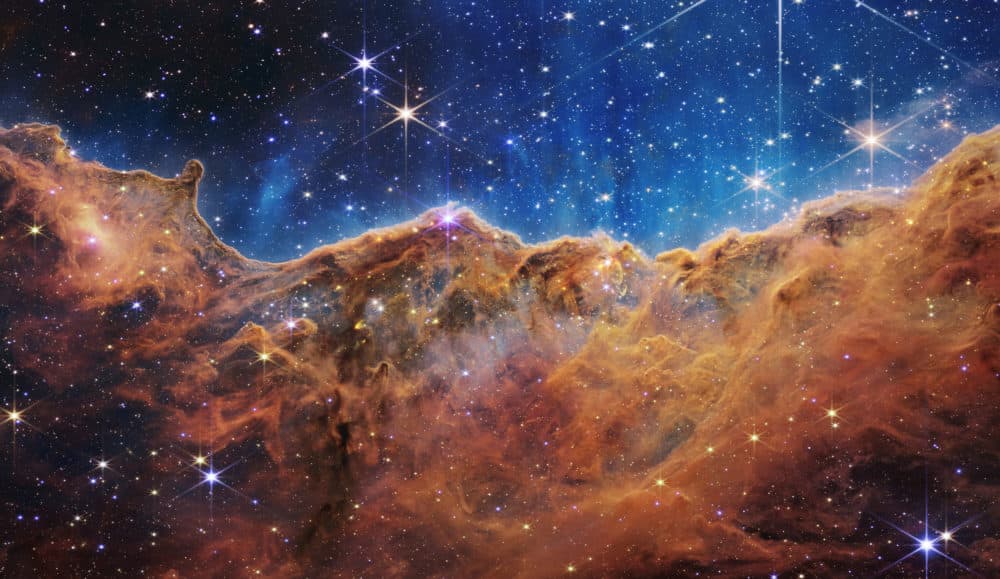Advertisement
James Webb Space Telescope: Humanity's deepest glimpse into the universe yet
Resume
Sign up for the On Point newsletter here.
Galaxies deeper into the universe than humanity has ever seen. Images of what's actually in the atmosphere of exoplanets.
The James Webb Space Telescope is revealing the spectacular multitudes contained within even the tiniest patches of dark sky.
"Watching it go into orbit, watching it unfold, watching every instrument, one by one get ready — there were hundreds of single-point failures with this telescope that if any one thing had not worked, the whole telescope would not have worked," astronomy professor Steve Finkelstein says.
But it is working — marvelously.
"It's almost seeing the universe writ large," Finkelstein says. "You can see all the way from the nearby universe to the most distant galaxies that humans have ever found. And already scientific papers are starting to come out."
Today, On Point: Scientists join us to explain how to understand what the James Webb Space Telescope is sending home.
Guests
Catherine Espaillat, Astrophysicist and Director of Boston University’s Institute for Astrophysical Research. (@DrCEspaillat)
Steve Finkelstein, associate professor of astronomy at the University of Texas at Austin. (@astrosteven)
Transcript of the Show's Introduction
Meghna Chakrabarti: Here’s an experiment I’d like you to try, at some point today. Find a grain of sand or even just a tiny, tiny pebble. Put it on the tip of your finger. Stretch out your arm and hold that grain of sand up to the sky. Now think about the miniscule area covered by that grain of sand. What could possibly be out there, in the universe, within such an impossibly small patch of sky?
Well, the answer is – more than you might dare hope for.
[Archival Tape/Jane Rigby]: The first focused images that we took where they were razor sharp – I had the very emotional reaction of, oh, my goodness, it works. Personally, I went and had an ugly cry.
Chakrabarti: This is On Point. I’m Meghna Chakrabarti. And that was Jane Rigby, operations scientist for the James Webb Space Telescope – describing her very understandable reaction to the first images released from the Webb to the public this month. The images, including the Webb’s First Deep Field, show thousands of galaxies – thousands – contained within that tiny, tiny patch of sky covered by area of the grain of sand on the tip of your finger. They are the deepest, sharpest infrared images of the distant universe that humanity has ever seen.
And when I first saw the Webb Deep Field image, that black backdrop of space literally swimming with galaxies, I felt like we were experiencing the cosmological version of what Dutch scientist Antonie van Leeuwenhoek might have felt circa 1670, when he put droplets of water under a microscope and became the first human to see, not a blank clear droplet, but an entire universe swimming with thousands of microbes. I like to think of van Leeuwenhoek’s jaw dropping, looking up from his microscope, and wondering, if this is what’s in but one drop of water, well then what else could be out there?
Now, about 350 years later, Scott Gaudi, astronomy professor at Ohio State University had much the same reaction when looking at the Webb telescope’s first images. "You start looking at this image and realize there's no blank sky," he said. "There's something crazy happening everywhere."
Well, today, we're going to talk about what the Webb Telescope's first images have revealed.
Your Questions, Answered
Can you give us details about how JWST will give us new and better understanding of dark matter, and/or dark energy?
Steve Finkelstein: Dark matter and dark energy – you know, they're 95 percent of the composition of our universe but the part we understand the least. One thing that we've been thinking about just over this weekend is, the best idea of what dark matter is is that it's some kind of particle that we just haven't discovered yet. And the longer scientists go without discovering that particle – there are many particle physics experiments around the world trying to identify a dark matter particle – the more different ideas come out of, well, maybe it's not that kind of particle. Maybe it's a less massive particle, maybe it's something else.
And one of the alternative ideas that have been coming out is just that it's a lighter type of particle called known as warm dark matter. The standard sort of accepted theory of dark matter is that it's called cold dark matter. And that just has to do with the mass of the particle. But if you look at predictions from cold, dark matter versus warm dark matter, warm dark matter cannot make galaxies in the early universe, at least not so early. And so by detecting early galaxies, we can immediately rule out an entire class of alternative dark matter models.
Regarding what we would see with the naked eye, I understand it from the distance we are, we do not see the detail that was mentioned about the cliffs. If we were much closer to that nebula would it look to us visually as it does in the enhanced photograph? Thank you!
Catherine Espaillat: It wouldn't look exactly like the picture because that's an infrared picture that's been color-coded. But … we would be able to see some emission in the visible. So, we would see some kind of colors. It'd be mostly like whitish, maybe with a bluish tinge because of the O-stars. But it wouldn't look exactly like that because we have to remember, that's been that's a processed image. It's been color-coded.
I’ve been hearing references to the images being color coded, but what exactly does that mean?
Finkelstein: Our eyes are sensitive to visible light because that's where most of our sun puts out light. So that's how we've evolved. And so what we do is we want to make an image we can see, right? If we put out Webb's first image, and it was just about blank screen, that wouldn’t be very exciting. So Webb can observe in multiple different filters.
And so I can look at blue, you know, sort of bluer infrared light – that would be higher energy, infrared light. And lower energy infrared light – we might call that redder infrared light. And we can combine those images in a way where we take the bluer infrared light and make that blue on our computer screens, the … redder light and make that red on our computer screens. And so whether we call it color coding or false colors, it's doing our best to represent how these objects would look if our eyes could see infrared light.
This program aired on July 25, 2022.

